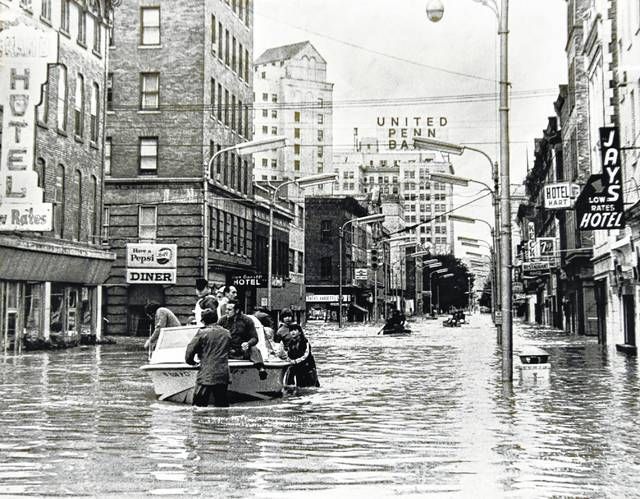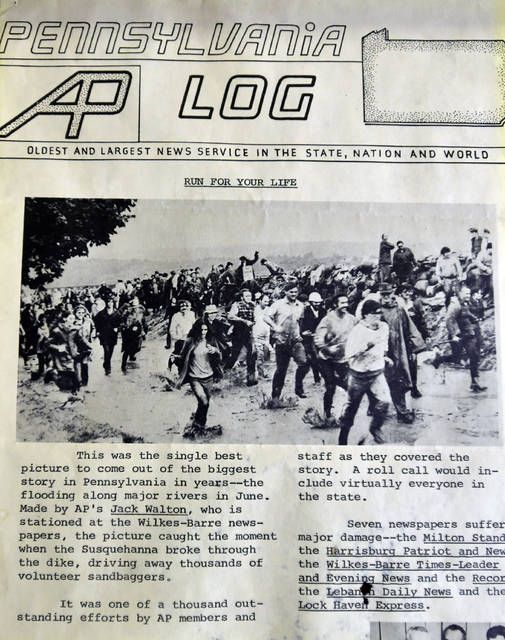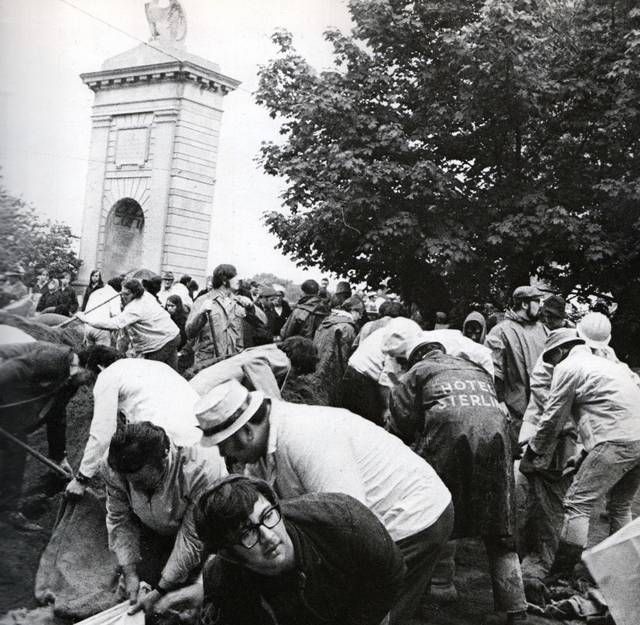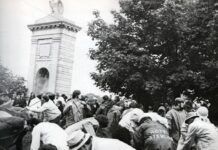
Downtown Wilkes-Barre is seen in June 1972 as the Agnes floodwaters swamped city streets. This view is looking west on East Market Street near Pennsylvania Avenue, approximately in front of where the Times Leader offices are located today.
Times Leader file photo
Click here to subscribe today or Login.
WILKES-BARRE — The deep emotional stain brought by the floodwaters of 1972 will never go away.
And as we observe the 49th anniversary of the Agnes Flood of 1972, the images and memories of the devastating event, that are embedded in our minds, remain.
On June 23, 1972, the Susquehanna River swelled to one mile wide, breaking through the levee system and rushing through our front doors, devastating property, legacies and life as we all had known it.
In preparation of what could happen, many people had taken everything they had and placed it in what they believed would be a safe place — a second or third floor of their homes. Items like photos, family treasures, diplomas, jewelry, records, books, baseball cards — everything that the great people of Wyoming Valley valued, were placed in boxes or on shelves or tucked away in closets or a spare room.
Everybody thought their items would be safe. They weren’t.
The Agnes flood exceeded all expectations.
Documentary forthcoming
Alan K. Stout has been spearheading the production of a documentary — “Agnes” — a non-profit project being done in cooperation with the Wilkes-Barre Preservation Society.
Stout said most of the work on the film is being done on a volunteer basis, but funding is needed to help cover production costs and licensing fees. The project, to date, has raised 70% of its fundraising goal and is still in need of approximately $12,000.
The film team includes Stout, producer; Bob Savakinas, director; Tim Novotney, editor; Tony Brooks, historical consultant; Richard Briggs, creative consultant.
For more information on the projects, go to the website — www.agnes72.com.
“We really do need to remember, recognize, respect and appreciate what the people of this community did in the summer of 1972, and how they rolled up their sleeves and got to work, pulled together, and put this valley back together,” Stout said.
The “Agnes documentary will be released on June 23, 2022, to note the 50th anniversary of the flood.
Stout said the documentary includes all of the video on file from all of the local TV stations, newspaper headlines from local newspapers from the summer of ‘72, photographs from all four of the pictorial books that were published on Agnes, local radio broadcasts recorded during Agnes, home videos and photos submitted by the public, and — for the first time — national news coverage from CBS, NBC and ABC news.”
Stout said he and the team wanted to properly document and preserve history for the people that remember and lived through Agnes, and for the younger generation that have been hearing about ‘the flood’ their entire lives from their parents and grandparents.
A modernization
Jim Brozena, former county engineer and former executive director of the Luzerne County Flood Protection Authority, is now a consultant.
“The interesting thing was that in 1972, we had a bunch of old tired communities,” Brozena said. “As horrible as the flood was, it did allow the entire valley to be somewhat modernized.
Brozena said with the tremendous infusion of millions of federal dollars, the greater Wyoming Valley saw improvements like the separation of sanitary and storm sewer systems, thousands of street improvement projects, new curbs, sidewalks and parks were created and many towns built new municipal buildings.
The flood of 1972 sort of gave those communities a fresh start,” Brozena said. “And it also served as the birth of the back Mountain and Mountain Top, with many families choosing to relocate to those elevated communities to escape the flood plain and the chance of another flood.”
And the flood provided the reason to convince the federal government and the U.S. Army Corps of Engineers to raise the levee system. Brozena said the levees were raised on average from three to five feet when it was authorized by Congress to fund the project that would protect against a recurrence of Agnes — which was the flood of record.
Quick fact: In 1972, the river level reached 41.09 feet — in 2011, the river level reached 42.69 feet.
Brozena said work on the levee raising began in 1972 and completed in 2005 at a cost north of $200 million. And the system has worked, even when it was severely tested in 2011 when the Susquehanna River rose to Agnes levels or higher.
“The levees saved this community in 2011 from same position we were in 1972,” Brozena said. “I believe the value of the protected area was estimated at $2 billion.”
Brozena also noted that there are several “unprotected:” towns along the river — Jenkins Township, Mocanaqua, West Pittston, Plains Township and Plymouth Township, to name a few. Brozena said since the 2011 river rising, more than 300 residences were acquired and demolished, avoiding future property damage and eliminating the risk to hundreds of people.
Brozena also saw the creation of the Riverfront Common Park, a $25 million project that incorporated two flood control portals and created a beautiful space along River Street.
Downtown perspective
Larry Newman, Executive Director at the Diamond City Partnership, said the 1972 flood is one of the defining events in the history of the Wyoming Valley – shaping almost every aspect of our community’s subsequent physical and economic development.
“Take Downtown Wilkes-Barre as an example,” Newman said. “Prior to Agnes, it had been slowly declining in the face of increasing suburban competition, and the city had begun using urban renewal to stop the decline. However, the flood dramatically accelerated both processes.”
Newman said the downtown’s post-flood reconstruction was far more comprehensive than it would have been otherwise. For better or worse, he said it swept away most of an aging commercial core, replacing it with dramatic new construction.
As a result, from 2007 through 2020, Downtown Wilkes-Barre saw a net gain of 55 occupied storefronts; 216 new market-rate housing units (with 30 more coming online in 2021), and more than $200 million in private investment. It became a college town, a startup hub, and a regional destination for dining and entertainment.
“Here’s an important lesson from 1972 – one that resonates in the aftermath of COVID — while we may not be able to change history, it’s also a mistake to let it knock us down,” Newman said.
Epilogue
But with higher levees that have stood a test or two in the last 49 years, can the residents and business owners in the flood plain ever feel comfortable?
“The answer is no,” Brozena said. “The levee system provides a great amount of protection and reduces risk, but as we saw in 2011, we never thought the river would rise as high as it did in 1972.”
So, as we look toward 2022 and the 50th anniversary of the Agnes Flood of 1972, is there reason to celebrate?
“It’s never a celebration — it’s an observance,” Brozena said. “There has been an increased focus on education about the river, which really is an asset to the region.
“It’s also a time to appreciate the power of the Susquehanna River, as we saw in 2011.”
Reach Bill O’Boyle at 570-991-6118 or on Twitter @TLBillOBoyle.










